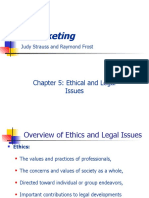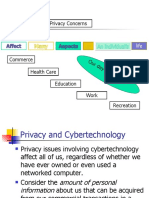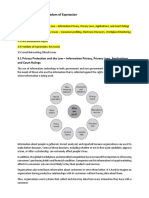Economics of Privacy
Critics of privacy
Richard A. Posner, The Right of
Privacy (1978)
Fred H. Cate, Principles of Internet
Privacy (2000)
2
�1- Richard A. Posner, The
Right of Privacy (1978)
• Economics of privacy
• We have two economic goods:
1. Privacy (We pay the price to conceal our privacy)
2. Prying (Others will incur costs to discover something about us)
vWhy are we interested in prying?
vWhen does it happen?
vIs prying necessarily bad?
3
�1- Richard A. Posner, The Right of Privacy
(1978)
• Exploitation opportunities through misrepresentation
• Are we really who we present in the society?
• Do we try to manipulate others’ opinions about us as our right to
control the flow of information about ourselves?
• Posner argues that “[…] others have a legitimate interest in
unmasking the deception.”
4
�1- Richard A. Posner, The Right of Privacy
(1978)
• Warren and Brandies attributed the rise of curiosity about people’s
lives to the excess of the press.
• Posner believed that gossip columns recount the life of successful
people as role models in the society.
“The economist does not believe, however, that supply creates demand.”
• Posner argues that prying existed long before press, in old societies where it was
easier for citizens to observe others’ lives.
• However, the wealthier and modern society offers press for surveillance.
5
�1- Richard A. Posner, The Right of Privacy
(1978)
• Decisions made by cost analysis
• Example:
• A magazine wants to sell the subscribers’ list to a third party
• Cost involved with obtaining consent and approval from subscribers compare
to the value of the list itself.
• Does the list have more value for the third party?
• Which decision makes sense economically?
6
�1- Richard A. Posner, The Right of Privacy
(1978)
• Much of the demand for privacy concerns discreditable information:
1. Information about criminal activity, moral conduct…
2. Private information that would clear misrepresentation by an individual
• Concealing serious health problems by a worker
• Concealing serious health problems from a prospective spouse
7
�1- Richard A. Posner, The Right of Privacy
(1978)
• Posner’s idea to the “right to be let alone”
• “Very few people want to be let alone. They want to manipulate the
world around them by selective disclosure of facts about themselves.”
8
�2- Fred H. Cate, Principles of Internet Privacy
(2000)
• The historical importance of information flow
• Enshrined by the First Amendment
• Freedom of expression
• Copyrights – to promote the creation and dissemination of expression
• Post office – to deliver the mail and news
• Democratic society and market economy is based on free-flow of data
9
�2- Fred H. Cate, Principles of Internet Privacy
(2000)
• Why open data flow matters?
• Deliver the right products and services to the right customers with a lower
price
• Information about individuals’ needs and preferences is the
cornerstone of any system that allocates goods and services within an
economy.
10
� Decision Making
Process
11
�Challenges in Preserving User’s Privacy
• Why there are differences between privacy attitude and behavior?
• Even privacy-conscious individuals engage in risky behavior!
1. Structural Asymmetry
2. Cognitive Biases
12
�Challenges in Preserving User’s Privacy
Structural Asymmetry
• Asymmetric information – Being unaware of all the activities that may affect
their privacy.
• Bandwidth problem –
• Asymmetric power
13
�Structural Asymmetry- Asymmetric
Information
• Intentional effort to mislead the individual
• Unintentional, where the organization neglects to explain some
aspect of how they handle data,
• Miscommunication where the organization is either using language
too obscure and complication, such as privacy policies, or the
individual simply doesn’t have the pre-requisite baseline knowledge
to understand what the organization is doing.
• The average consumer in the US has a 10th grade reading level
14
�Structural Asymmetry- Bandwidth problem
• Economics of Scale
• Even if the organizations fully disclose their activities, individuals don’t have
the time to understand everything that happens around them.
• One company, too many customers.
• Companies manage one effort to disclose information about their
data practices.
• Individuals, on the other hand, must expand effort to read and
understand each privacy notice.
• The average consumer needs to spend 76 days a year to read each
and every privacy notice for all the services they use.
15
�Structural Asymmetry – Asymmetric power
• Economics of Scale
• Even if they are aware and have the time to fully understand the
ramifications, they maybe powerless to find alternatives.
• Businesses tend to leverage economies of scale through standard
contract terms, reducing individualized transaction cost.
• Customization is expensive for businesses.
• If an individual doesn’t agree with the terms of service, they are likely
to be dismissed because the loss is negligible to the bottom line.
• Take-it-or-leave-it
• No privacy preferences
16
�Challenges in Preserving User’s Privacy
Cognitive Biases : deviation from rational behavior
• Endowment effect
• Hyperbolic discounting
17
�Cognitive Bias – Endowment effect
• People have irrational differences in how they value privacy depending on
whether they are being sked to pay for that privacy or give it up in exchange for
something.
• Consider a telephone directory:
• Scenario 1 (No privacy): There is an option for an individual to pay a monthly fee
and keep their phone number out of the directory. How much would you pay?
• Scenario 2 (default: privacy): The company will pay you some amount of money
to include your phone number in the directory. How much would you ask?
• By defaulting to no privacy, business are taking advantage of irrational
undervaluation.
18
�Cognitive Bias – Hyperbolic Discounting
• A time inconsistency in people’s views of present versus future
discount.
• Misperception of the magnitude of an adverse consequence in the
future over the same consequences occurring in the present.
• An individual uploading a photo from their drunken night at a
conference avoids LinkedIn (WHY?), but will happily upload it to
Instagram (WHY?)
• Discounting behavior: “a year's salary, an additional year of
experience for better employment prospects, time value of future
money versus present money”
19
�Hyperbolic Discounting – Spam Email
Example
• Hyperbolic discounting can explain present cost avoidance behavior
• Individual facing the possibility of future spam
• not opting to use an email provider with disposable email addresses
despite the benefits.
• Most individuals do not use such a provider, even though spam may
have an outsized future consequence
• Consequences: inconvenience, monetary cost of an anti-spam filter,
false positives lost to the anti-spam filter, and risk of malware or
other malicious use of their contact information.
�Summary
• Cascading effects where people are ill equipped to make rational
decisions about privacy
• Unaware of activities that affect their privacy
• Even if the companies disclose their activities, individuals need time to
understand everything
• Even if users are aware of all practices and have time to understand, they may
be powerless to find alternatives
• Irrational privacy valuation
• Discounting of future risk for immediate gratification
�• The odds are stacked against individuals to protect their privacy!
• What to do next?
























































































